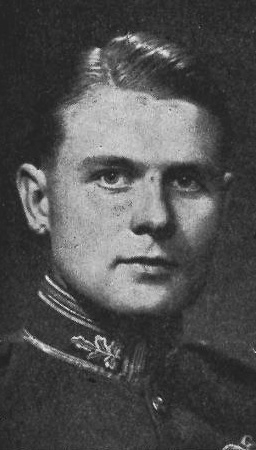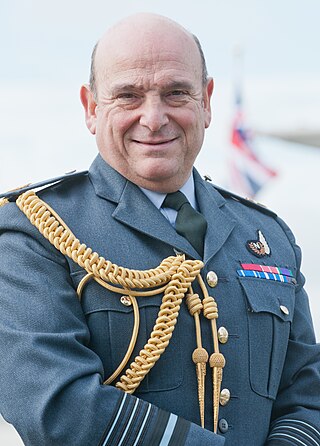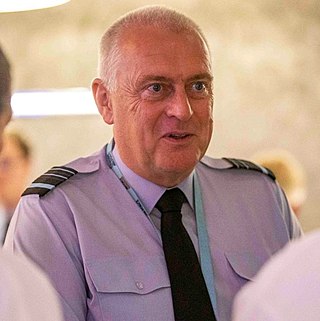
Marshal of the Royal Air Force (MRAF) is the highest rank in the Royal Air Force (RAF). In peacetime it was granted to RAF officers in the appointment of Chief of the Defence Staff (CDS), and to retired Chiefs of the Air Staff (CAS), who were promoted to it on their last day of service. While surviving Marshals of the RAF retain the rank for life, the highest rank to which officers on active service are promoted is now air chief marshal. Although general promotions to Marshal of the Royal Air Force have been discontinued since the British defence cuts of the 1990s, further promotions to the rank may still be made in wartime, for members of the Royal Family and certain very senior RAF air officers in peacetime at the discretion of the monarch; all such promotions in peacetime are only honorary, however. In 2012, the then Prince of Wales was promoted to the rank in recognition of his support for his mother, Queen Elizabeth II, in her capacity as head of the armed forces (commander-in-chief), while in 2014 Lord Stirrup, who had served as Chief of the Air Staff and Chief of the Defence Staff for over seven years, was also promoted.

Marshal of the Royal Air Force Sir Edward Leonard Ellington, was a senior officer in the Royal Air Force. He served in the First World War as a staff officer and then as director-general of military aeronautics and subsequently as controller-general of equipment. In the inter-war years he held command positions in the Middle East, in India and then in Iraq. He served as Chief of the Air Staff in the mid-1930s and in that role he implemented a plan, known as 'Scheme F'. This scheme implemented an increase in the size of the Royal Air Force to 187 squadrons within three years to counter the threat from Hitler's Germany. He also broke up the command known as "Air Defence of Great Britain" to create RAF Fighter Command, RAF Bomber Command, RAF Coastal Command and RAF Training Command. He then served as Inspector-General of the RAF until his retirement in 1940.

Air Chief Marshal Sir Richard Edward Johns, is a retired senior Royal Air Force commander. He was a fighter pilot in the 1960s, commanding officer of a squadron during the 1970s and a station commander in the 1980s. Johns served as one of three British directors of operations on the senior planning staff for Operation Granby in 1991 and then acted as a supporting commander for joint operations in the Balkans in 1994. As Chief of the Air Staff he advised the British Government on the air force aspects of the Strategic Defence Review and on NATO's air campaign in Kosovo.

Marshal of the Royal Air Force Sir Andrew Henry Humphrey, was a senior officer in the Royal Air Force. He fought in the Second World War as a fighter pilot taking part in the Battle of Britain and also took part in the withdrawal from Aden in November 1967. He served as the Chief of the Air Staff advising the new Labour Government on the implementation of their latest Defence Review. He then served as Chief of the Defence Staff but caught pneumonia within three months of taking office and died shortly afterwards.
Air Chief Marshal Sir Michael James Graydon, is a retired Royal Air Force (RAF) officer. He was a fast jet pilot in the 1960s, a squadron commander in the 1970s and a station commander in the 1980s before serving as Air Officer Commanding-in-Chief RAF Strike Command during the Gulf War. He was Chief of the Air Staff from 1992 to 1997 in which role he advised the British Government on the implementation of No Fly Zones in Iraq and Bosnia and implemented the Front Line First initiative.

Marshal of the Royal Air Force Graham Eric Stirrup, Baron Stirrup,, informally known as Jock Stirrup, is a former senior Royal Air Force commander who was the Chief of the Defence Staff from 2006 until his retirement in late 2010. He is now a Crossbench member of the House of Lords. In April 2013, he was appointed a Knight Companion of the Order of the Garter by Queen Elizabeth II.

Air Chief Marshal Sir Glenn Lester Torpy, is a retired senior Royal Air Force (RAF) commander. He was a fast jet pilot in the late 1970s and 1980s, saw active service during the Gulf War and then went on to higher command. He was the air component commander on Operation Telic and served as Chief of the Air Staff, the professional head of the RAF, from 2006 to 2009. In that role Torpy hosted the RAF's biggest air display in two decades, and argued for consolidation of all British air power in the hands of the RAF.

Marshal of the Royal Air Force Sir William Forster Dickson,, was a Royal Naval Air Service aviator during the First World War, a senior officer in the Royal Air Force during the inter-war years and a Royal Air Force commander during and after the Second World War. Dickson was Chief of the Air Staff in the mid-1950s, in which role his main preoccupation was the establishment of the V Force and the necessary supporting weapons, airfields and personnel. He also served as the first Chief of the Defence Staff in the late 1950s.

Marshal of the Royal Air Force Samuel Charles Elworthy, Baron Elworthy, was a senior officer in the Royal Air Force. He served as commander of a squadron of Blenheim bombers and then as a station commander during the Second World War. He became Chief of the Air Staff in the mid-1960s and implemented the cancellation of the TSR-2 strike aircraft and the HS681 military transport aircraft programmes. He also became Chief of the Defence Staff in which role he oversaw the evacuation from Aden in November 1967 and had to respond to the growing crisis in Northern Ireland in the late 1960s.

Marshal of the Royal Air Force Sir Keith Alec Williamson, was a senior officer in the Royal Air Force. He served with the Royal Australian Air Force flying Meteors in a ground attack role during the Korean War. He was a squadron commander and then a station commander during the 1960s and a senior air commander in the 1980s. He was Chief of the Air Staff during the early 1980s at the time of the emergency airlift of food and supplies to Ethiopia.

Air Chief Marshal Sir Christopher Hugh Moran, was a fast jet pilot and later a senior commander in the Royal Air Force. He was Commander-in-Chief of Air Command at the time of his unexpected death.

Air Marshal Sir Richard Frank Garwood, is a retired senior Royal Air Force officer.

Air Chief Marshal Stuart William Peach, Baron Peach, is a British retired senior Royal Air Force officer. After training as a navigator, Peach commanded IX (Bomber) Squadron and then became Deputy Station Commander RAF Bruggen. He was deployed as NATO Air Commander (Forward) in Kosovo in 2000. He went on to be Chief of Defence Intelligence in 2006, Chief of Joint Operations in 2009 and the first Commander of Joint Forces Command in December 2011 before being appointed Vice-Chief of the Defence Staff in May 2013. Peach succeeded General Sir Nick Houghton as Chief of the Defence Staff on 14 July 2016. He succeeded General Petr Pavel as Chairman of the NATO Military Committee on 29 June 2018, serving as such until his retirement from NATO in June 2021.

Air Chief Marshal Sir Stephen Gary George Dalton, is a retired senior officer of the Royal Air Force and former Lieutenant-Governor of Jersey.

Air Marshal Sir Stuart David Atha,, is a former senior officer of the Royal Air Force. He led No. 3 (Fighter) Squadron from 2000 to 2004, which included deployment to Iraq on Operation Telic, commanded RAF Coningsby (2006–08), No. 83 Expeditionary Air Group (2009–10) and No. 1 Group (2011–14), and served as the Air Component Commander for security during the 2012 London Olympics. Atha was RAF Deputy Commander Operations from 2016 to 2019.

Air Marshal Sir Barry Mark North, is a retired senior Royal Air Force officer, who served as Deputy Commander (Personnel) at RAF Air Command. A helicopter pilot, North has held command appointments at all levels, notably No. 78 Squadron in the Falkland Islands, the Special Forces Flight as a squadron leader and the newly established No. 83 Expeditionary Air Group in the Middle East as an air commodore.

Air Chief Marshal Sir Andrew Douglas Pulford, is a retired senior Royal Air Force (RAF) commander. A helicopter pilot with operational service in Northern Ireland, the Falklands War and Iraq War, Pulford commanded RAF Odiham and No. 2 Group, and served as Assistant Chief of Defence Staff Operations, before taking up the post of Deputy Commander-in-Chief Personnel at Air Command and Air Member for Personnel in 2010. He became Chief of the Air Staff on 31 July 2013, retiring from the Royal Air Force on 12 July 2016.

Air Marshal Gregory Jack Bagwell, is a retired senior Royal Air Force (RAF) commander who served as Deputy Commander (Operations) at RAF Air Command.

Air Chief Marshal Sir Michael Wigston, is a former senior officer in the Royal Air Force, who served as Chief of the Air Staff from 26 July 2019 until 2 June 2023. He previously served as Assistant Chief of the Air Staff from 2017 to 2018, and Deputy Commander (Personnel) and Air Member for Personnel and Capability from 2018 to 2019.

Air Marshal Sir Gerard Michael David Mayhew, is a former senior Royal Air Force officer, who served as Deputy Commander Operations, Headquarters Air Command between May 2019 and August 2022.




















